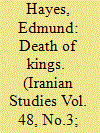|
|
|
Sort Order |
|
|
|
Items / Page
|
|
|
|
|
|
|
| Srl | Item |
| 1 |
ID:
137389


|
|
|
|
|
| Summary/Abstract |
Ferdowsi's Shahnameh was not conceived as a national epic, but it does encapsulate another kind of group identity: it provides context and meaning for the glorious pedigree of the Iranian aristocracy. Ferdowsi himself was a member of the Khorasani dehqān gentry whose collective effort in the tenth century CE was turned towards preserving and reshaping their own history and literary heritage in the terms of the new era. This article analyzes the final section of the Shahnameh, dealing with the reign and death of the last Sasanian king, Yazdegerd III. As such, this section provides crucial clues for the function of the Shahnameh as a means to construct meaning for Ferdowsi's own group in his own time. The description of this crucial moment in history, pivoting between the era of Iranian kingship and the Islamic era, suggested possible modes for interpreting the present. The study reads this section of the Shahnameh with close attention to the use of the word nezhād (“lineage”), which circumscribes the identity of both the aristocrats of Ferdowsi's present, and the kings and heroes of the mythic past. In doing so, the transition between eras appears as a tragedy of nezhād, as the Sasanian dynasty is extinguished, raising permanent existential ambiguities for the entire class of Iranian gentry whose genealogies were associated with it.
|
|
|
|
|
|
|
|
|
|
|
|
|
|
|
|
| 2 |
ID:
159818


|
|
|
|
|
| Summary/Abstract |
This contribution discusses two striking twenty-first-century cases of the global spread of Shiʿism beyond the Middle East, with a particular focus on accompanying processes of localization. On the arid Guajira Peninsula shared by Colombia and Venezuela, Teodoro Darnott, a self-declared liberator of an indigenous people, has framed Shiʿism as a revolutionary ideology that helps justify the Wayúu people’s struggle for self-determination. In Cambodia, however, Shiʿism has recently entered a Muslim community in this predominantly Buddhist country on somewhat different terms. Here, its localization involved a re-emphasis on ancient traditions of the local Cham people that trace the spread of Islam among them to Imam ʿAli. It is precisely the vastly different contexts of the two cases that highlight that the localization of Shiʿism has, in these cases at least, paradoxically gone hand in hand with cultural revival and a quest for the preservation of local culture.
|
|
|
|
|
|
|
|
|
|
|
|
|
|
|
|
| 3 |
ID:
169257


|
|
|
|
|
| Summary/Abstract |
Religious knowledge is at the heart of the Shiʿi system of clerical authority known as the marjaʿiyya. Given the multiplicity of more or less well-established claimants to the position, this article explores the scholarly credentials of the contemporary marjaʿ[source of emulation; pl. marājiʿ]. I conceptualize the marjaʿiyya in accordance with Pierre Bourdieu’s notion of the field in order to examine how scholarly capital is defined, and possibly redefined, by 14 religious scholars competing in this marjaʿiyya field in Iraq. To do so, I use their ‘official’ biographies in Arabic and analyze the types of credentials of scholarly capital that are put forth to legitimate the claims of these marājiʿ. I argue that, despite the multiplicity and diversity of contenders, there is a fair degree of homogeneity in the ways scholarly capital is defined. In the biographies, the marājiʿ’s scholarly capital is validated against three broad indicators: their inherited scholarly capital, which stems from their family background; their educational capital; and the intellectual-scientific prestige capital derived from their scholarly and teaching activities. The credentials emphasized in the different biographies are generally much alike, and if a marjaʿ does not satisfy them, ‘almost-like’ credentials are constructed. Abidance to shared codes and practices reflects, as well as contributes to, the stability of the marjaʿiyya field.
|
|
|
|
|
|
|
|
|
|
|
|
|
|
|
|
| 4 |
ID:
177795


|
|
|
|
|
| Summary/Abstract |
This paper examines the notions of Shiʿism and kingship in Safavid cultural materials (coins, architectural inscriptions, enthronement orations, and panegyrics) to trace the role of Safavid ideology in the dynasty’s transformation from a Sufi order into a monarchic institution with a sectarian identity. It examines these materials in order to reconstruct the dominant ideology of the Safavids in various venues. Examination of the ideologies of Safavid rulership shows a marked difference between ideologies expressed in these cultural mediums. We argue that this difference points to a multi-pronged Safavid strategy of projecting political legitimacy in distinct registers for different audiences. By combining ideologies that were embraced and practiced by people of different regions and sects in the Persian empire before the Safavids, the Safavid monarchs managed to spread widely their power within the empire and beyond, to change the religio-political ideology of the empire, and to remain in power for more than two centuries.
|
|
|
|
|
|
|
|
|
|
|
|
|
|
|
|
|
|
|
|
|